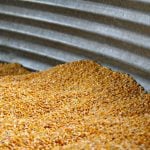When a nice buck lined up in his sights, Ray Hilderman pulled the trigger and fired his canola into the market.
He bagged a farmgate price of $8 per bushel, a target he set during the growing season.
But he admits being a little reluctant to sell, because even though canola futures prices are relatively good, basis levels are bad right now. His $8 price came with a catch: the canola moves off his Strasbourg, Sask., farm now, but he doesn’t get paid until Feb. 1 by the grain company. Officially he’s selling in January, when basis levels are better than today’s.
Read Also

Chinese offer complicates canola marketing
Recently the Chinese ambassador indicated that there would be a potential deal between Canada and China regarding the current tariff war.
“We decided we wanted eight bucks for our canola, so when that was offered, we took it,” said Hilderman.
“I hope we did the right thing. Last year we had $10 canola that we sold for less than $9.”
Prairie farmers, many with full bins of canola for the first time in three years, are getting conflicting messages from the market. On the one hand, historically attractive futures prices seem to be calling farmers to deliver. On the other hand, wide basis levels from grain companies and crushers seem to be telling producers to keep their canola at home until it is wanted.
Ron Styles, a commodities broker with Union Securities in Saskatoon, is urging farmers to lock in a commodity price and wait out the basis storm.
“It’s an extraordinarily wide basis at the moment and the only way around it is to use the futures market to make a substitute sale,” said Styles.
“If you think the price is attractive now, that’s a way you can lock it in.”
Statcom Ltd. canola market analyst Nolita Clyde said many farmers suspect the grain companies of gouging them with big basis charges, but that probably isn’t the case.
The grain companies are getting squeezed at Vancouver, where high ocean shipping charges are cutting into the price they can charge buyers. Foreign buyers don’t care about what portion of the canola price is basis and how much is the futures-derived price, she said. All they care about is the total price.
“The reality is that when Canada sells in the world market, we sell at a flat price,” said Clyde.
“Most buyers don’t think in terms of basis. They don’t buy that way.”
Clyde said the wide canola basis on the Prairies is due to the grain companies compensating for high futures prices by broadening the basis. That’s necessary to keep buyers buying.
“If we tack on a normal basis level (at Vancouver), say $20 over on Winnipeg Commodity Exchange levels, right now we wouldn’t see any export demand,” said Clyde.
“Our futures are following Chicago, but our cash prices don’t need to be that high.”
Chicago soybeans have risen because American farmers had a short crop, but Canadian farmers harvested an average canola crop and should not assume buyers will drive the market higher or continue to follow soybeans.
“We’re not short of canola,” said Clyde.
Farmers shouldn’t get obsessed by the basis level, she said. The farmgate price is still good.
“What has happened right now is a gift from soybeans to the canola market,” said Clyde. “If the U.S. had not run into a soybean problem, we’d probably be trading six buck canola.”
Styles agreed that today’s canola futures prices could easily fade.
“If there isn’t any demand, there’s a good chance prices will slide,” said Styles.















